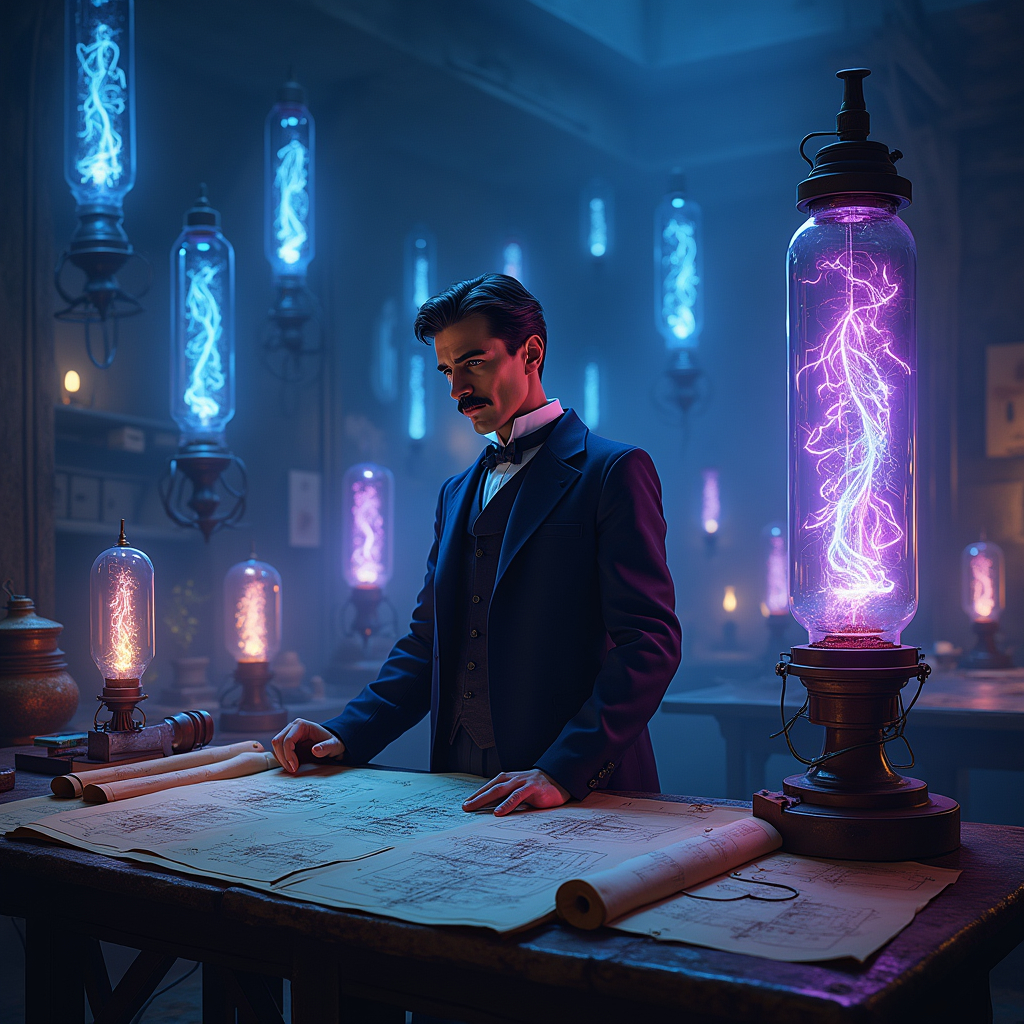High-Frequency Currents and Wireless Lighting
Tesla Coil and Gas Tubes
In 1891, Tesla invented the Tesla coil (US Patent 454,622), a device capable of generating high-frequency alternating currents. He demonstrated wireless power transmission by lighting gas-filled tubes without direct electrical contact. These demonstrations culminated in his famous lecture “Experiments with Alternate Currents of Very High Frequency and Their Application to Methods of Artificial Illumination”.
Patents and Applications
Tesla patented designs for gas-discharge lamps, emphasizing their efficiency and wireless operation. These experiments laid the foundation for modern gas lighting technologies.
Experiments with X-Rays
Claims Before Röntgen
As early as 1894, Tesla noticed photographic plate damage and skin irritation, phenomena later associated with X-rays. However, he did not systematically study or publish these findings before Wilhelm Röntgen, and a major fire in his laboratory disrupted further research.
Contributions After Röntgen
After 1895, Tesla actively developed vacuum tubes for X-ray generation and pioneered imaging techniques. His work included focused X-ray beams, lead shielding, and patents such as US Patent 613,809 (1898).
Designs of Electronic Tubes
Various Configurations
Tesla experimented with:
- Modified Crookes tubes
- Single-electrode tubes
- Gas-pressure modulated tubes
Patents
His devices, such as the “Incandescent Electric Light” (US Patent 454,622), and later X-ray tube designs, reflect his innovation in electronic tube technologies.
Key Patents and Publications
- US Patent 454,622 (1891) – High-frequency lighting systems
- US Patent 1,209,359 (1917) – Advanced X-ray tube designs
- Lectures and Books – Detailed experiments documented in The Inventions, Researches and Writings of Nikola Tesla (1893).
Confirmed Contributions
Tesla undoubtedly advanced high-frequency technology, wireless energy transmission, and early X-ray techniques. Although his claim to discovering X-rays before Röntgen remains debatable, his innovations in the field are internationally recognized.
Mysterious Drafts in His Legacy
According to documents from the Nikola Tesla Museum, several sketches in Tesla’s legacy depict tubes with unusual geometries and electrode configurations. Some researchers speculate these might be related to:
- Teleforce projects (“death rays”)
- Wireless long-distance energy transmission
- Experimental resonant systems
Theories About the Purpose of the Unclassified Tubes
High-Energy Particle Beams
Possible components for focusing electron or ion streams.
New Types of Lighting
Experimental designs with spiral electrodes and multilayered structures.
Undeveloped X-ray Projects
Concepts for “cold” low-vacuum X-ray tubes.
Challenges in Interpretation
- Missing Documents – A large portion of Tesla’s personal archives was confiscated by the U.S. government after his death in 1943, and some materials remain lost or classified.
- Technical Ambiguity – Without Tesla’s detailed descriptions, it is difficult to reconstruct the exact function of the devices based only on the sketches.
Key Sources for Further Research
- Colorado Springs Notes (1899–1900)
- US Patent 1,329,559 (1917) – “Valvular Conduit”
- Wizard: The Life and Times of Nikola Tesla (Marc Seifer)
Conclusion
Tesla’s genius in harnessing electrical phenomena for practical applications is undeniable. His experiments with electronic tubes paved the way for modern gas lighting, high-frequency technologies, and early radiographic techniques. Although many of his designs remain mysterious, they stand as a testament to his boundless innovative spirit.
Tesla also left behind numerous unfinished or unexplained designs, including tubes of unknown purpose. Most theories are based on fragmentary data and speculation. The intricate sketches likely stemmed from his research into high frequencies, particle physics, or wireless technologies, but their exact applications remain a mystery.
👉 The series of posts about Nikola Tesla will continue on MilovanInnovation.
In the next post, we will explore Tesla’s World Wireless System — a visionary project aiming for global communication and wireless energy transmission.


Leave a Reply